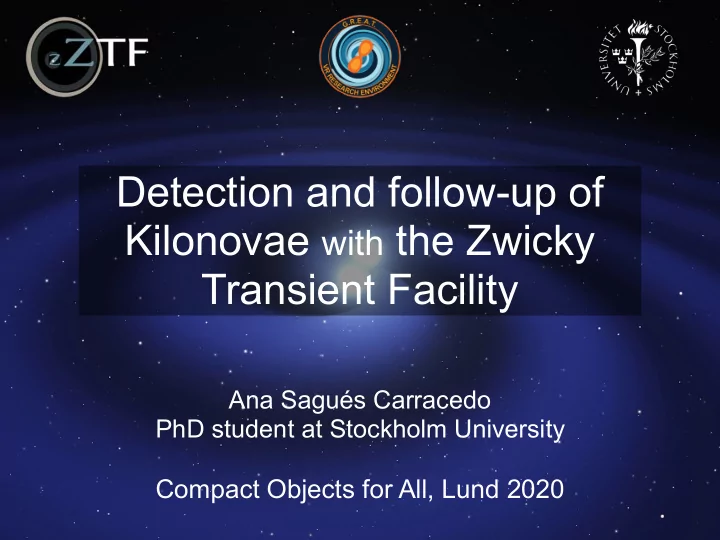

Detectability of Kilonovae with Zwicky Transient Facility Detection and follow-up of Kilonovae with the Zwicky Transient Facility Ana Sagués Carracedo Astronomdagarna 2019 Ana Sagués Carracedo PhD student at Stockholm University Compact Objects for All, Lund 2020
Outline • Introduction of kilonovae • Kilonovae search • Survey simulations • Serendipitous observations
Introduction Introduction Binary neutron star merger (BNS) Electromagnetic counterpart Gravitational wave signal Short GRB Kilonova Image: NASA Virgo Collaboration Metzger et al. 2012
AT2017gfo GW170817 • Nearby, only 40 Mpc • Very well localised • Short GRB • UV/optical/infrared kilonova Kasliwal et al. 2017 B. P. Abbott et al. � 4
Kilonovae search Observational challenges • Fast-evolving transient • Relatively faint (M abs ~-16) • Viewing angle dependence • Rare objects • Only one event Iair Arcavi et al. 2017
Kilonovae search Observational challenges • Fast-evolving transient • Relatively faint (M abs ~-16) • Viewing angle dependence • Rare objects • Only one event How can we find them? • LIGO/Virgo public alerts • Dedicated surveys Iair Arcavi et al. 2017
LIGO/Virgo public alerts S190910h S190814bv Extremely bad! Extremely good! 50% area: 8040 deg 2 50% area: 5 deg 2 90% area: 24264 deg 2 90% area: 23 deg 2 https://gracedb.ligo.org/superevents/public/O3/ � 7
Filters: g , r and i ZTF Zwicky Transient Facility � 8 Samuel Oschin/P48 Telescope exterior
Survey simulations Simsurvey: Python package for simulating the lightcurves obtained by an astronomical transient survey Output Inputs Observed lightcurves that Survey plan pass the detection criteria Kilonova model Detection criteria https://simsurvey.readthedocs.io/en/latest/
Survey simulations Simsurvey: Python package for simulating the lightcurves obtained by an astronomical transient survey Output Inputs Observed lightcurves that Survey plan pass the detection criteria Kilonova model In this work: • Optimistic survey : g r and i, t wice per night, Detection criteria same depth • Viewing angle distribution • Detection criteria: 2 detections with S/N >= 5 https://simsurvey.readthedocs.io/en/latest/
Viewing angle dependence Pole Equator Bulla et al. 2019
Pole Equator
Pole Equator
Pole Equator
Pole Equator
Pole Equator
Pole Equator
Limiting magnitude = 20.5 gr Pole Equator
Limiting magnitude = 20.5 gr Pole gri Equator
Limiting magnitude = 22 gr Pole gri !! Distance x2 Volume x8 Equator
Serendipitous observations of Kilonovae with the ZTF Preliminary results 20 months of ZTF data • No kilonova detection Kilonova rate < 4545 Gpc -3 yr -1 Comparing with SNe rates (Gpc -3 yr -1 ) SN Ia ~30000 SN Ibc ~22500 SN IIn ~7500 SN IIp ~120000 Detection criteria : 2 detections S/N>5 in at least two filter. Work in progress… Non-detection within 20 days before and after. Time-period with S/N > 5 less than 25 days
Summary • Dedicated observations required to improve detection probability. • We present a tool that allow us to understand detections and non-detections, optimize the observing strategy and estimate rates
Recommend
More recommend